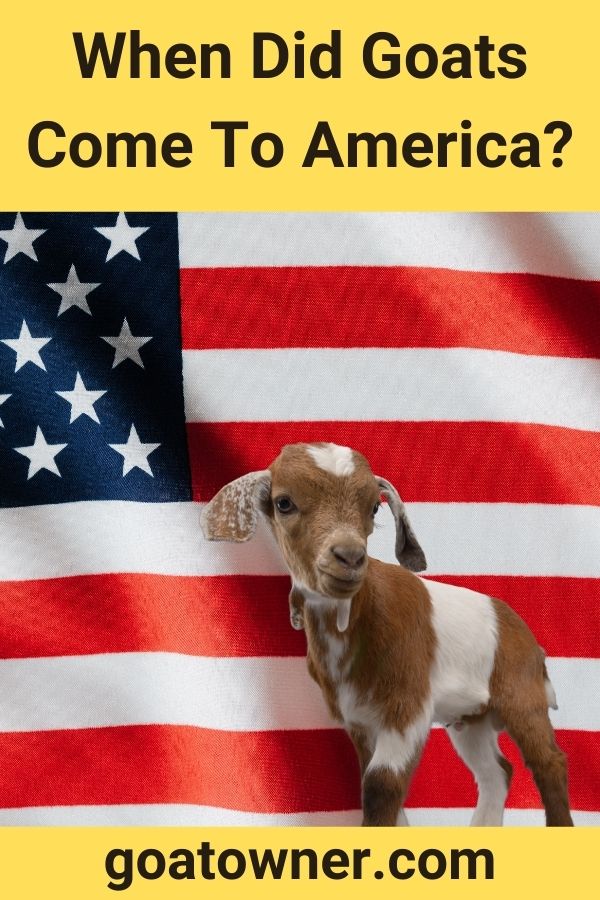I was quite surprised to learn recently about the differences between prehistoric cultures of the Americas versus other parts of the world.
Even though it would have been obvious had I just thought about it, someone pointed out that South America in particular lacks a lot of the large animals that characterize Eurasia.
These cultures had to rely on plant proteins like beans, squash and maize for protein.
I wondered, then, about goats in America in general—were they native, or if not when did they come?
So, when did goats come to America?
Though it is difficult to say with much certainty, it seems goats arrived with Spanish colonizers in the 16th Century. There are no indigenous goat species in the Americas. They were slowly introduced over the centuries following the initial discovery of the continent by European explorers.
Given that the written records are incomplete and permanent colony settlements on the continent were quite sparse for centuries after its discovery, it’s very tricky to say with any accuracy when the first goat populations were first brought to America.
Our best estimate puts the introduction at some time before the middle of the 16th Century.
Are goats native to America?
No, they aren’t.
There are no breeds of goat or even goat-adjacent creatures that are native to any part of the Americas.
Goats evolved mainly in Eurasia, which is where they were first domesticated by humans.
Goat hooves would not touch the soil of any part of the Americas until human explorers brought them there.
There are, now, areas of the Americas which do have endemic goat populations.
That is to say, goats which live there in a semi-wild state, having been essentially introduced by humans.
But this is not the same, strictly speaking, as saying they are native to those places—they didn’t originate there.
That said, there’s nothing about the climate of most parts of the Americas which precludes goats from living there.
As I said, there are many endemic populations which thrive.
It’s simply that goats never made their way far enough to reach the American continents.
So, let’s look at how they originally reached the U.S.
How did the goat get to the U.S.?
Given that they weren’t native, there’s really only one way goats could have ever reached the U.S.: human intervention.
And this is precisely what happened.
Our earliest available and reliable records suggest that Spanish settlers brought goats, on a permanent basis, for the first time around the first half of the 1500s.
As I mentioned, permanent European settlements were extremely sparse for a rather long time.
Much of the western part of the U.S. wasn’t explored until the 19th Century.
Though there were many established colonies by the 18th Century, this was still a pale reflection of the size of the U.S. now.
All of this is to say that goats were introduced into the United States very gradually.
Populations would have been exclusively domestic, and indeed, for the most part, still are.
Where did goats originally come from?
Again, estimates do vary, and there is a fair amount of debate surrounding this issue.
As far as our domestication of them goes, our earliest evidence for that suggests the domestication process began around 11,000 years ago.
This was right around the time humans were, on a large scale, transitioning from hunter gatherer lifestyles to sedentary, farming lifestyles.
This transition from wandering, nomadic ways of life to what we might more commonly recognize as civilisation occurred earliest in the Middle and Near East.
This, also, is roughly where modern goats are thought to have evolved.
They were originally descended from an animal called the pasang, native to Asia.
Our earliest records of these animals are found in Persia.
So, goats came from the East, essentially, and it’s not surprising that they were domesticated as they were given this fact.
Human settlements were cropping up in many, many places in that part of the world, and goats were a perfect candidate for domestication.
They are mostly docile and peaceful, and produced rich, nutritious milk.
So, goats came from somewhere in the East, essentially.
Do we know who brought them to America?
Who brought goats to America?
We, unfortunately, do not know for sure.
Some reports suggest Columbus himself eventually brought goats to America, and according to some he brought them on that first journey in 1492.
There are no confirmed reports of this, though.
The best evidence we have is of a variety of Spanish explorers bringing goats to the Americas in the 1500s.
This, however, was not just to North America—but to the South, too.
So, no one person brought goats to America.
They came slowly, as part of a deluge of livestock brought by European explorers.
When exactly the first goats arrived is hard to say—whether they stayed even harder to say.
America is a big place, and a lot of people wanted to stake their claim after it was discovered.
A lot of those same people also reared goats.
As you can see, the answer really is not clear—questions like this can rarely be answered with much certainty.
We can say for sure that goats first arrived, permanently, in America sometime in the early 1500s.
However, we cannot really say by exactly whom, what the goat population was, whether multiple attempts were made to introduce them.
Few records would go into such detail, and even if they did, we can’t really be sure the surviving records provide a full picture.

